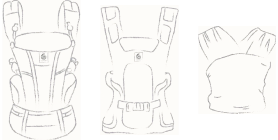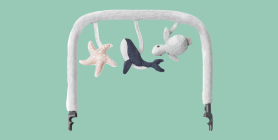- Home
- Blog
- Health Professionals
- The Secure Base of Attachment Parenting – Sir John Bowlby, his time and ideas
September 01, 2011
There certainly is no dearth of websites and organizations which offer information on parenting and baby development. However, the Attachment Parenting International (API) organization is one of the relatively few organizations which offer a coherent, comprehensive and practical approach to raising children, based on a very specific set of values. And what is more important, the advices that API puts forth, are based on solid scientific insights, developed over the past some 60 years.
The fundamental ideas of API stem from the pioneering work of Sir John Bowlby who formulated the concept of Attachment Theory. His work has subsequently inspired hundreds of researchers across the globe. They have strived to refine the concepts to make them even more applicable for parents and to assist early care workers in their efforts to help babies and children who have not had initially good circumstances.
In this article we will take a look at the founder of Attachment Theory, Sir John Bowlby – his time, what inspired him and his fundamental concepts. And what questions we should ask ourselves in our day and time.
This journey will take us to a time where children had little contact with parents, where children’s reactions to being separated from their parents would be dismissed as psychopathological fantasies and where a child was thought to need no more than food and shelter. Sadly, fragments of these misconceptions of bygone days still linger among us, which makes the work of API so important.
But let us begin with looking at Bowlby’s life and how he was formed by his experiences.
Bowlby’s life and career
Sir John Bowlby (1907-1990) was born into an upper middle class family in England, where his father worked as a surgeon to the King’s Household. As customary at that time, he saw his mother only one hour a day after teatime, though during the summer she was more available. Like many other mothers of her social class, she considered that parental attention and affection would lead to dangerous spoiling of the children. Bowlby was lucky in that the nanny in his family was present throughout his childhood. When Bowlby was almost four years old, his beloved nanny, who was actually his primary caretaker in his early years, left the family. Later, he was to describe this as tragic as the loss of a mother.
He was also sent to a boarding school at the age of seven, and later revealed that he thought this time as being terrible. Because of these experiences, he displayed sensitivity for children’s sufferings throughout his life.
He went on to study psychology at Cambridge, where he also had a six month stint with teaching maladjusted and delinquent children. Here he was touched by how some of these children would avoid attaching themselves to anyone. At the same time, he experienced that he was able to make contact with the children, which inspired him to train as a child psychiatrist and psychoanalyst.
Working for a period, prior to World War II, at the Child Guidance Clinic in London he noticed how the childhood experiences of parents influenced the difficulties that their own children were having. And that many of these difficulties would be relieved, if the parents were allowed to discuss and reflect on their own childhood experiences.
After the war, in 1946, he became the leader of the children’s department at the Tavistock Clinic in London where he worked until his retirement in 1972. In this capacity, he organized a research unit whose main task was to investigate the effects of separation of mother and child and also to elucidate which aspects of the mother-child interactions and relation were vital for the development of the individual personality.
After World War II which led to millions of children becoming orphans he authored a monograph on behalf of the World Health Organization in 1951 which summarized the – sparse - available knowledge on the negative effects of the absence of maternal care on the development of the individual personality. In the course of his writing, it became apparent to him that a coherent theory for the effects that were so visible in the real world was sorely missing. This propelled him to eventually begin formulating the concepts of Attachment Theory, which he elaborated on until his death in 1990.
The fundamental concepts of Attachment Theory
Food or comfort?
At the time Bowlby grappled with formulating his concepts, the baby was thought to seek out the mother, primarily for the reason that she was the supplier of food. So if the mother did not supply food, the baby would not form any specific ties to her. The baby’s primary need and source of attaching to anyone, in this angle, would be that of food. And because of this need, the baby would be dependent on the mother/feeder. Dependency was thus considered an infantile trait that should be outgrown eventually.
Bowlby however found that it was not the mother as a feeder, but the mother as a communicating, protective and empathetic figure that gave rise to an attachment of a given baby. In this perspective, the baby would be an inherently or intrinsically social being with a need to communicate and to form emotional relations to an adult.
This distinction may seem trivial, but it was crucial in the way it shaped society’s perception of what constituted sufficiently good child care. If food (and shelter) is indeed the primary need of a baby, then an orphaned baby or even a baby with its parents ought to be satisfied when it is no longer hungry, and no attempts should be made to communicate or form ties to the child, as it would only strengthen the baby’s dependency on the parents or the caregiver.
Dependency…
The concept of dependency which should necessarily and unyieldingly over time lead to gradually greater independence was another concept, which Bowlby found was inadequate to explain the behavior of children. What if a four year old, during a period of elevated stress, were to seek out the parents and need considerably more attention and closeness than normally? Should this behavior be considered a regression of the four year old to a more infantile stage of dependency (which should have been completed long ago) and the child therefore be rejected so as to not encourage the child to remain in its infantile and regressed state? Yes, was the common answer at the time. Sadly, this view still informs the practice and approach of some parents when dealing with stressed children.
Attachment and exploration
Bowlby over time developed a more flexible concept, whereby the baby from around 7-8 months would form a selective attachment to a specific caregiver. This caregiver would be whichever person who more or less consistently provided physical and emotional security to the baby. The baby would use this attachment figure – the caregiver – as a secure base in its discovery of the surrounding world, much in the same way an Arctic expedition team will make excursions out in the local unpredictable and occasionally precarious environment and return to the base camp for rest and recreation.
When the baby faced incomprehensible or threatening situations in its exploration of the environment, it would activate its attachment behaviors, be it crying, shouting or crawling back to the attachment figure. Attachment behavior is designed to attract the attention of the caregiver and to bring about greater physical closeness to the caregiver, which in the baby’s mind equals security.
So the two behaviors of exploration and attachment respectively would wax and vane, depending on the baby’s perception of the environment. If the environment seemed safe, and the caregiver was physically present, the baby would set out to explore the environment and the attachment behavior would be deactivated. When then a perceived threat appeared, the attachment system would become activated and the active exploration of the environment would be temporarily suspended.
Viewed from this perspective, it would be utterly natural and expected that any baby will occasionally need the attention, comfort and solace of a caregiver, and bids for comfort from the baby should naturally be heeded and met. A radically different position to the one outlined above where the baby was considered to be regressing when needing the caregiver.
Internal Working Models
Exactly this very way that the individual caregiver responds to the baby’s bids for comfort would in Bowlby’s perspective be what ultimately shaped the baby’s perception of the nature of relations to other people. He dubbed this mechanism “internal working model”.
This “internal working model” arises as a result of the baby’s own activities and experiences with the real environment and its caregiver(s), and is not, as some psychoanalysts insisted at that time, based on fantasies. The baby will use its working model to predict what to expect from the outside world and the working model thus also influences the baby’s intentions and behaviors. And what is even more crucial, the working model shapes the baby’s perception of itself as being e.g. pleasant, fun and worthwhile to be with, or a general nuisance which is fundamentally in the way, all depending on the way, the caregivers/parents deal with the baby.
Patterns of Attachment
This concept of an “internal working model” was later validated by one of his students, Mary Ainsworth, who found that babies at 12 months would display very specific patterns of attachment which were directly related to the quality of caregiving that they had been exposed to in the preceding months. Please refer to Antje Hein’s article in this month’s issue of Ergoparent for more details on these patterns of attachment.
Subsequently, researchers have followed groups of children, whose patterns of attachment were established at age 12 months, through their childhood and early adulthood. These patterns of attachment were found to form a trajectory or a general style of the individual child in how this child, and later, adult, would meet the world and form relations to others. If a child was found to be insecurely attached at 12 months, the odds were that this pattern would persist throughout childhood and adulthood, to the detriment of the child – and its surroundings.
However, one word of caution, attachment status at 12 months does not equal unyielding fate. The nature of the human soul is so that it will doggedly try to resolve past negative experiences and their resultant disadvantageous relationship patterns. Some are fortunate to run into people who in various and sometimes mysterious ways help them overcome the past so that they become able to form healthy and constructive relations, despite all prior obstacles.
Nevertheless, Bowlby pointed out some fundamental mechanisms between a baby and its caregivers/parents and thereby initiated a much needed adjustment of parenting practices, and we are still indebted by his tireless and deep commitment to creating good and mentally healthy conditions for our children.
What are the blind spots of our time?
In hindsight, we may be shuddering at the views and ways of our grandparents’ time, which to us now seem insensitive and callous, but rather than riding on a moral high horse, we might do well in asking ourselves what are the challenges that we face in our time.
The ubiquitous synthetic chemicals that we voluntarily surround us with – and which seem to affect fundamental biological systems relating to immunity and reproduction – could be one such challenge. And perhaps we are still underestimating how closely connected we are to our evolutionary ancestors when it comes to providing vital skin to skin contact in the baby’s formative months. In the past few years, science certainly has been uncovering hitherto unknown relations of mammalian hormonal systems (which date back millions of years) to the quality of parenting and the baby’s development.
Many parents have certainly come a long way, but far too many across the globe are still struggling and the quest for securing a healthy childhood for all has really only just begun. Organizations like Attachment Parenting International and researchers like John Bowlby are indispensable in this quest and they deserve our respect and support.
























